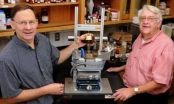(Press-News.org) BIRMINGHAM, Ala. – Cigarette smoke shuts off a key enzyme in airways that regulates the body's response to inflammation, according to findings from the University of Alabama at Birmingham published online today at Science Express.
The UAB researchers say smoke inhibits the enzyme, called Leukotriene A4 Hydrolase (LTA4H), causing it to fail in its job of shutting down white blood cells following a successful response to inflammation.
The team says the research study identified a previously unknown substrate of LTA4H called proline-glycine-proline (PGP). In a normal response to inflammation, PGP's role is to recruit neutrophils – white blood cells – that rush to the scene and attack the cause of the inflammation. When the job is over, LTA4H steps in to shut off PGP, in turn halting the recruitment of neutrophils and ending the body's defensive stand.
"We found, however, that cigarette smoke inhibited LTA4H, preventing it from shutting down PGP," said J. Edwin Blalock, Ph.D., senior author and professor in the UAB Division of Pulmonary, Allergy and Critical Care Medicine. "A continued presence of PGP means a continued response of neutrophils, a never-ending cycle that supports chronic inflammation."
Blalock said PGP is a biomarker for several lung diseases that feature chronic inflammation, such as chronic obstructive pulmonary disease (COPD) and cystic fibrosis.
The study also details a dual role played by LTA4H in suppressing or encouraging inflammation. When contained within a cell, LTA4H has a pro-inflammatory job, generating an agent know as Leukotriene B4 (LTB4), which, much like PGP, calls in the neutrophils when required. However, when LTA4H is found outside of the cell (when the cell it resides in dies, for example) its role switches to an anti-inflammatory one, as it works to suppress PGP and end the body's inflammatory response.
"This dual role was poorly understood until we identified PGP," said Blalock. "This could have important ramifications for the design of new anti-inflammatory drugs that target LTA4H."
Blalock said that because too much LTB4 can contribute to chronic inflammation, pharmaceutical manufacturers are examining potential drugs to inhibit LTA4H, thus reducing the amount of LTB4. Blalock said he believes that approach needs revision.
"Drugs are in design that would reduce LTB4 by shutting down LTA4H," he said. "But we now know that LTA4H has a beneficial role to play in the reduction of PGP.
"While inhibiting LTB4 might be a good thing, to simultaneously block LTA4H's ability to degrade PGP defeats the purpose, and may make the situation worse."
###
This study was supported by grants from the National Heart, Lung and Blood Institute, one of the National Institutes of Health.
Blalock collaborated with Robert Snelgrove, Ph.D., of the Imperial College London, along with colleagues at the University of Montevallo (Montevallo, Ala.), the Birmingham Veterans Affairs Medical Center and the UAB Lung Health Center, Gregory Fleming James Cystic Fibrosis Center and Department of Pediatrics.
About UAB
Known for its innovative and interdisciplinary approach to education at both the graduate and undergraduate levels, the University of Alabama at Birmingham (UAB) is the state of Alabama's largest employer and an internationally renowned research university and academic health center whose professional schools and specialty patient care programs are consistently ranked as among the nation's top 50; find more information at www.uab.edu and www.uabmedicine.org.
EDITOR'S NOTE: The University of Alabama at Birmingham (UAB) is a separate, independent institution from the University of Alabama, which is located in Tuscaloosa. Please use University of Alabama at Birmingham on first reference and UAB on second reference.
END
COLUMBUS, Ohio – There is yet no straightforward way to determine the optimal dose level and treatment schedules for high-dose radiation therapies such as stereotactic radiation therapy, used to treat brain and lung cancer, or for high-dose brachytherapy for prostate and other cancers.
Radiation oncologists at the Ohio State University Comprehensive Cancer Center-Arthur G. James Cancer Hospital and Richard J. Solove Research Institute (OSUCCC-James) may have solved the problem by developing a new mathematical model that encompasses all dose levels.
Typically, radiation ...
BETHESDA, Md., Sept. 2, 2010 – The American Society for Biochemistry and Molecular Biology expressed its disapproval and disappointment this week in response to the Aug. 23 ruling in the U.S. District Court for the District of Columbia that granted a preliminary injunction barring federal funding of embryonic stem-cell research.
In a statement, the society said the decision, which came in response to a lawsuit filed by two adult stem-cell researchers, effectively halts human embryonic stem-cell research in the United States and "represents a crossroads in American scientific ...
COLLEGE PARK, Md. – A new report by terrorism researchers at the University of Maryland concludes that the deadly hostage-taking incident at the Discovery Communications headquarters in suburban Washington, D.C. meets the criteria of a terrorist act – a rare one for media organizations and the nation's capital region. Hostage-taking, though, is a familiar pattern in capital-region terror, the researchers add.
The report from the University of Maryland's START Center – the federally funded National Consortium for the Study of Terrorism and Responses to Terrorism – also ...
Tropical Depression Nine strengthened yesterday into Tropical Storm Gaston, but today it ran into dry and stable air and weakened back into a depression again.
When NASA's Aqua satellite flew over Gaston early this morning, Sept. 2 at 0423 UTC (12:23 a.m. EDT), the infrared image taken from the Atmospheric Infrared Sounder (AIRS) instrument showed that Tropical Depression Gaston seemed to have a compact circulation with some high, cold thunderstorm cloud tops around its center of circulation. Those clouds reached so high into the troposphere that they were colder than ...
AMES, Iowa – Iowa State University researchers have found a way to produce high-value chemicals such as ethylene glycol and propylene glycol from biomass rather than petroleum sources.
Walter Trahanovsky, an Iowa State professor of chemistry who likes to write out the chemical structures of compounds when he talks about his science, was looking to produce sugar derivatives from cellulose and other forms of biomass using high-temperature chemistry. And so he and members of his research group studied the reactions of cellulosic materials in alcohols at high temperatures ...
ANN ARBOR, Mich. — School children who consume foods purchased in vending machines are more likely to develop poor diet quality – and that may be associated with being overweight, obese or at risk for chronic health problems such as diabetes and coronary artery disease, according to research from the University of Michigan Medical School.
The study also looked at foods sold in school stores, snack bars and other related sales that compete with USDA lunch program offerings and found that these pose the same health and diet risks in school-aged children.
"The foods that ...
NASA's Terra satellite captured the changing Tropical Storm Kompasu over Korea and China very early today, as it makes its way east to northern Japan. It is becoming extratropical.
The Moderate Resolution Imaging Spectroradiometer (MODIS) instrument aboard NASA's Terra satellite captured a visible image of Tropical Storm Kompasu at 02:15 UTC on Sept. 2 (10:15 p.m. EDT Sept. 1) as it was moving over Korea and China. The storm appeared disorganized as there was no visible center of circulation. The Joint Typhoon Warning Center, the organization that forecasts tropical ...
Singapore, September 3, 2010 — Novartis announced today that scientists at the Novartis Institute for Tropical Diseases (NITD), in collaboration with researchers from the Genomics Institute of the Novartis Research Foundation (GNF), the Swiss Tropical and Public Health Institute and The Scripps Research Institute have discovered a novel compound that shows promise as a next generation treatment for drug resistant malaria. Major support for the project was provided by the Wellcome Trust, the Medicines for Malaria Venture (MMV), A*STAR, Singapore and the U.S. government.
Published ...
Female induced pluripotent stem (iPS) cells, reprogrammed from human skin cells into cells that have the embryonic-like potential to become any cell in the body, retain an inactive X chromosome, stem cell researchers at UCLA have found.
The finding could have implications for studying X chromosome-linked diseases such as Rett syndrome, caused by mutations in a gene located on the X chromosome.
The findings differ from those seen in mouse skin cells that are reprogrammed into iPS cells, in which the inactive X chromosome reactivates, said Kathrin Plath, senior author ...
Uninsured minority pedestrians hit by cars are at a significantly higher risk of death than their insured white counterparts, even if the injuries sustained are similar, new research from Johns Hopkins suggests.
The death rate disparity is compounded by the fact that minority pedestrians are far more likely than white pedestrians to be struck by motor vehicles, according to a study published in the August issue of the journal Surgery.
"It's a double whammy," says Adil H. Haider, M.D., M.P.H., an assistant professor of surgery at the Johns Hopkins University School ...


